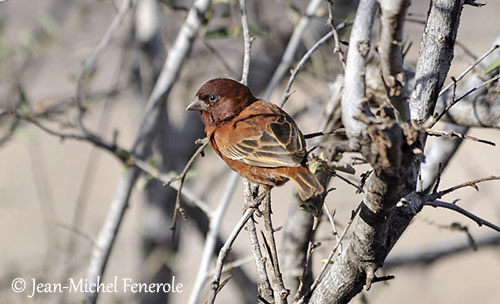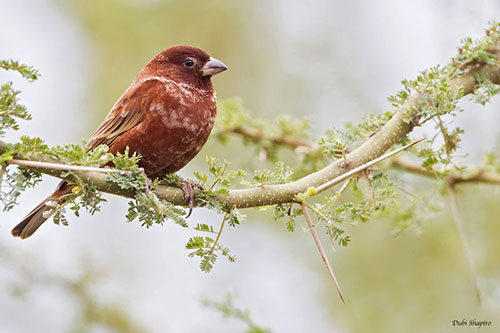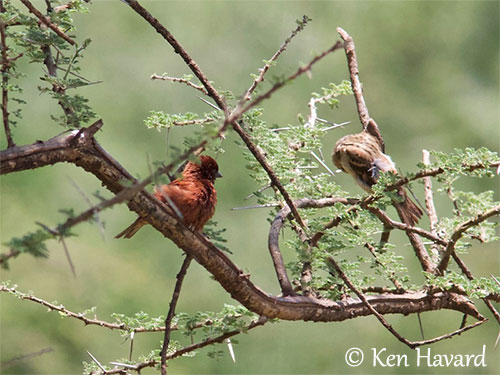
The Chestnut Sparrow is nomadic and forms large flocks that wander extensively outside breeding season.
The Passeridae have broad, rather short wings and are usually strong fliers.
REPRODUCTION OF THIS SPECIES:
The breeding season coincides with the rains. However, this period could be determined by that of the host species.
The Chestnut Sparrow breeds in single-species colony or in mixed-species colony with Ploceidae species.
The nest is an untidy globular structure and there is a side entrance. It is made of dry grass and lined with feathers. It is placed in tree, often in weaver’s nest, an abandoned nest or more often after owners are ejected.
The female lays 3-4 white to bluish-white eggs. In captivity, the incubation lasts 18-19 days. Nothing is known on the duration of nesting and fledging periods. Nestlings are possibly fed by the female alone.
The nesting behaviour of this species requires further study.
PROTECTION / THREATS / STATUS:
The Chestnut Sparrow is described as common to locally common.
The size of the population is unknown, but it is suspected to be stable.
The species is not globally threatened for the moment, and the Chestnut Sparrow is currently evaluated as Least Concern.
Fr: Moineau d’Emin
Ang: Chestnut Sparrow
All: Maronensperling
Esp: Gorrión Castaño
Ita: Passera castana
Nd: Kastanjemus
Sd: kastanjesparv
Photographers:
Jean Michel Fenerole
Photos d’Oiseaux du monde
Ken Havard
My Bird Gallery & Flickr gallery 1 & Flickr gallery 2
Dubi Shapiro
Dubi Shapiro Photo Galleries
Text by Nicole Bouglouan
Sources:
HANDBOOK OF THE BIRDS OF THE WORLD Vol 14 by Josep del Hoyo-Andrew Elliot-David Christie - Lynx Edicions – ISBN: 9788496553507
BIRDS OF AFRICA SOUTH OF THE SAHARA by Ian Sinclair and Peter Ryan - Princeton University Press Princeton and Oxford - ISBN: 0691118159
FINCHES AND SPARROWS by Peter Clement, Alan Harris and John Davis – Helm Identification Guides – ISBN: 0713652039
The Sparrows by Denis Summers-Smith – Editeur: A& C Black, 2010 – ISBN: 1408138255, 9781408138250 - 352 pages
BIRDS OF EAST AFRICA vol 1 by C.A.W. Guggisberg – Mount Kenya Sundries Ltd. – ISBN: 9966889051
Birds of the Horn of Africa: Ethiopia, Eritrea, Djibouti, Somalia, and Socotra - Revised and Expanded Edition – Editeur: Princeton University Press, 2016 – ISBN: 0691172897, 9780691172897 – 512 pages
Wikipedia, the free encyclopaedia
Chestnut Sparrow
Passer eminibey
Passeriformes Order – Passeridae Family
INTRODUCTION:
The Chestnut Sparrow is the smallest member of the family Passeridae, with a length of 11 centimetres. It is found in East Africa, from Darfur in Sudan to Tanzania, where it frequents dry acacia savanna near swamps and also near human habitations. It feeds mainly on grass seeds.
This species builds an untidy structure in tree, but it often occupies the weaver’s nests. It breeds in loose colonies.
The Chestnut Sparrow was first described in 1880 by Gustav Hartlaub. The scientific name pays tribute to the explorer Emin Pasha who collected the type specimen. It is occasionally named Emin Bey’s Sparrow.
This species is described as common to locally common, and it is not globally threatened for the moment.
DESCRIPTION OF THE BIRD:
Biometrics:
Length: 11 cm
Weight: 12-17 g
The Chestnut Sparrow adult male in breeding plumage has dark chestnut plumage overall, except for the blackish-brown wings and tail, both showing chestnut-edged feathers. There is a small pale patch at base of primaries.
The head, and especially the face, is darker and browner than the body.
The thick bill is black to blackish or grey. The eyes are dark brown. Legs and feet are pale brownish.

Outside breeding season, the male usually shows flecks of white, especially on the underparts. The bill is horn-coloured.
The female has grey-brown head to upper mantle. Lower mantle and scapulars are chestnut-brown with dark brown streaking. The area from back to uppertail-coverts is more rufous. Tail and wings show paler and buffer edges.
On the underparts, the breast is dull chestnut, belly and flanks are buff.
On the head, we can see a chestnut-buff supercilium. Chin and centre of throat are chestnut. The bill is paler than that of the male.
The juvenile resembles female but it is paler, with chestnut tinge on rump and lesser upperwing-coverts. The chestnut colour is usually absent on throat and face.
The male immature has pale body plumage with chestnut blotches, but the head is darker.
RANGE:
The Chestnut Sparrow is found from Western Sudan (Darfur province), Ethiopia (Rift Valley), N and NE Uganda through Kenya S to NE, C and E Tanzania. This species has been recently recorded in C Chad.
HABITAT:
The Chestnut Sparrow frequents dry grasslands or savannas, often with bush or scrub, also acacia tickets. It is often observed near marshes and papyrus swamps, and even in villages or near human habitations.
CALLS AND SONGS: SOUNDS BY XENO-CANTO
The call of the Chestnut Sparrow is described as a soft chirping. At nest, the male gives a high-pitched twittering trill.
The flight call is a ringing “chup chup chup”, whereas a dry scolding is given during threat behaviour “chrrrrit”.

BEHAVIOUR IN THE WILD:
The Chestnut Sparrow is primarily granivorous and feeds mostly on grass seeds. It feeds on the ground where it takes various grass and weed seeds. But household scraps and insects are also part of the diet. The young are mainly fed on small insects until they fledge.
The Chestnut Sparrow breeds colonially or loosely colonially. The globular nest of this species can be built in single-species colonies, but sometimes, they are situated in weaver’s colonies (Ploceidae). In this case, the Chestnut Sparrow may use an abandoned weaver’s nest, or it ejects the weavers from an occupied nest.
However, from some observations, the Chestnut Sparrow also breeds in colonies consisting entirely of self-built, typically untidy sparrow-like nests (Cunningham-van Someren).
The Chestnut Sparrow male displays from the weaver’s nest, sometimes still occupied, to attract a female. She may help the male to drive out the owners.
Does this species evolving from a normal breeder to a nest parasite species? We will see in the future.
Another observation (Payne’s study) indicates that the sparrows only appropriated active nests, whereas abandoned structures were ignored.
The male displays in front of the nest by crouching and shivering the wings in shallow V above the back, while producing a twittering trill. This is an advertising behaviour also used to attract a mate.
When a female approaches, the display becomes more intense and the male bows deeply while spreading and depressing the tail. The wings are almost upright over the back.
When the female is ready for mating, she joins the male at the nest and crouches with the head drawn in and pointed upwards, while the wings are slightly spread and shivering. Then, the copulation occurs, during which the male’s wings are shivering, and it pecks at the nape feathers of the female.
